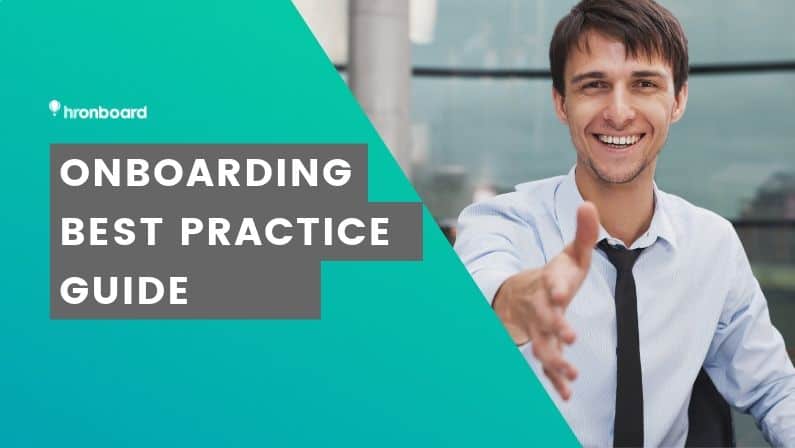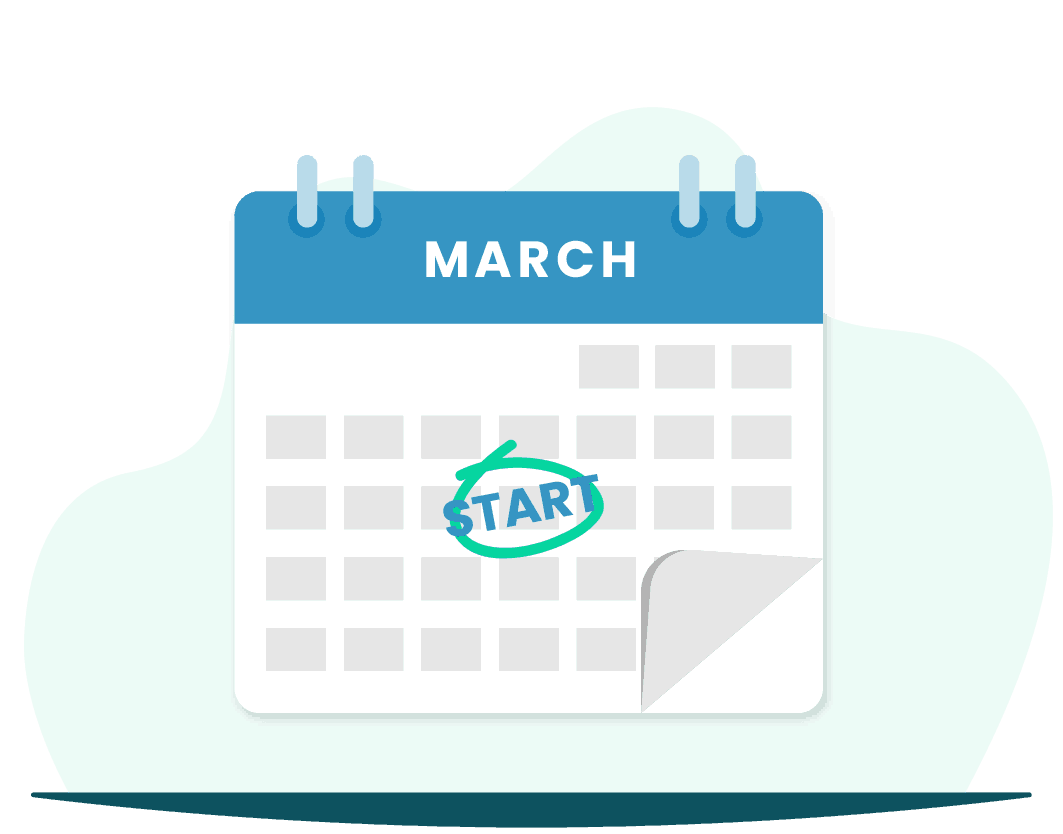Employee Onboarding Best Practices: The Ultimate Guide
(Updated For 2020)
Onboarding is a broad term that captures many of the critical moments in an employees critical first year. Those critical moments can vary depending on your unique circumstances. To help you navigate these treacherous waters, we’ve created the ultimate guide to employee onboarding best practices.
The 16 Steps To Onboarding Best Practice
- 1. Provision employees before they arrive
- 2. Get paperwork out of the way
- 3. Get the team involved (and aware)
- 4. Share important first week information
- 5. Assign a buddy
- 6. Live and breathe your employer brand
- 7. Create an epic welcome
- 8. Get immersed in the culture
- 9. Plan the ramp into meaningful work
- 10. Share cascading goals & set clear OKRs
- 11. Reinforce key teams, stakeholders & book in regular chats
- 12. Inspire new hires
- 13. Plan probation management
- 14. Celebrate first year anniversary & early wins
- 15. Continually optimise your employee onboarding
- 16. Download the guide
Onboarding is one of those catch all phrases – it can mean many things to different teams. A typical onboarding process begins when a candidate accepts their first job offer, their induction and through to potential transitions between teams (we call this crossboarding). While this is largely a formal process, there are still lots of ways to make onboarding fun.
One common theme remains, onboarding is the process that ensures new hires are ready for whatever comes at them – from procedural to cultural learnings. Studies show new hire productivity comes faster with an efficient and enticing onboarding experience, with 90% of employees deciding whether to stay with the company with the first 6 months of starting. So why do so many get is so wrong?
In this guide, we’ll walk you through the best practices for employee onboarding that you can personalise to your team, industry and candidates. Leading to a better experience for the individual, and a better outcome for the business.
If you’re just looking for a straightforward onboarding checklist, we’ve got you covered! (just not in this guide)
Now, before getting too far ahead and thinking about the content – begin by mapping out your onboarding journey and processes. Visualise your employee experience and determine if it sparks joy and contentment.
We’re a big fan of going a little old school for this – think giant whiteboard, some post it notes, coloured markers etc.
Assemble a group of onboarding influencers from across the team – team leaders, recent new hires, payroll & HR managers, GMs, recruiters and P&C – add some delicious pastries, some great coffee and you’ve got the perfect environment to brainstorm your way to better onboarding!
Now that your caffeinated, get your sharpees at the ready – let’s get started!

Before day one is a phrase you’ll hear a lot around HR. And you’ll be forgiven for not quite understanding what that means. What do new hires want from their future, but not quite yet, employer? How frequently should we engage? What are appropriate information or tasks?
Here’s some news that might surprise you: candidates want to know what’s expected of them before they arrive on their first day. And while a few want to know so they can be the best employee ever to have ever graced your boardroom; most just don’t want to look silly, go to the wrong office or be dressed to impress on casual Fri-yay.
Let’s walk through the best practices of pre-day one onboarding communication for new employees.

1. Provision employees before they arrive
Delays during onboarding give the impression your new hire is not expected to be productive immediately – or that you can’t be bothered ensuring they are set up for success. Two vibes you don’t want to foster after expending so much energy getting them onboard!
Here are some of the more common onboarding tasks (and a few less so) to get you started:
- Security logins & access keys
- Desk – you’d be surprised how often this one gets forgotten!
- Computer, tablet or phone (or BYOD registry)
- Monitors, cables, pesky adaptors
- Logins for hardware, password management tools, role specific software & apps
- Profile created and logins shared for time and attendance tool
- Specialist tools & equipment
- Uniforms & personalised name tags
PRO TIP
Not sure what a new hires needs? Talk to their team leader or colleague and walk through a typical day in the life – you’ll quickly uncover items or logins you might not have thought of.
That way, you can welcome your new hire with the confidence they will have everything they need, because you went through the steps yourself!
2. Get paperwork out of the way
Paperwork is the most boring, confusing, and frustrating part of the onboarding process. So much can be held up by a missing signature on one piece of paper or an illegible bank number.
Key paperwork that should be completed before day one:
- Employment contract
- Policies that require acknowledgement
- Payroll forms – banking, tax and Super
- VISA & Work requirements
- Police & Working with Childrens checks
Get your paperwork out of the way as soon as possible. The faster you finish off paperwork, the faster you can focus on the engagement side of onboarding. Electronic acceptance is a simple work around to speed up the paperwork time as it removes the delays of postage, filing and manual data entry.
Not only will it speed up your time to hire impressively – you’ll create an epic first impression with your new hires.
PRO TIP
To create a memorable first impression (for the right reasons!) you need to up the level or warmth during onboarding.
You can do this by ensuring every interaction in personalised to the job, team or individual.
3. Get the team involved (and aware)
Beyond HR, other employees, teams, and departments should also be involved in the onboarding process. These teams have a significant impact on a new hire’s engagement.
For example, the line manager may be an employee’s key point of contact, but it is likely that they will also benefit from access to HR for company policy and payroll-related queries, and IT for access to the right tools and equipment.
For this reason, it’s important that all internal stakeholders have proper access and transparency into the onboarding process, along with a clear outline of what their tasks are. It’s certainly a big ask for already-busy HR professionals, so consider automating task requests.
Communication from the team leader is essential before day one. From the time the contract is signed, it’s critical for new employees to begin building a rapport with their manager.
How to keep team leaders engaged is a hot topic in HR. Their input is important to create an effective employee journey – yet they are often frustrated with red tape and process. There are two core activities you can do to keep every manager ‘in the loop’ and engaged with the new starters journey.
- ‘Nudge’ a team leader by assigning key tasks and deadlines
- Why not get team leaders to leave a ‘welcome message’ to the new starter?
61% of Best-in-Class onboarding businesses give their managers visibility into the status of new hires. You should too!
By including managers in the process (rather than just relying on HR), you ensure that best practices for onboarding are followed. If managers understand what employee onboarding is about, the effects it can have on engagement and the positive effect it will have on staff retention, they’ll be more than happy to do their part.
Part of this process should facilitate two-way feedback. HR needs to tell managers who the at-risk employees are. Managers need to share information about new hires’ performance, experience and engagement to HR to help refine the new hire process.
PRO TIP
You can help team leaders become epic managers by automating some handy prompts and reminders. They can easily add a personal touch or if they’re lacking inspiration or time-poor, there’s a handy default message to get them started)
Personalsiation can be used to scale up team leader interactions. You can nudge leaders with prompts, default content to get the process rolling.
4. Share Information that will Impact New Starters in their First Week
People love to join organisations that align with their values and beliefs. It’s important to keep reinforcing your culture, brand and unique style to new starters before day one.
Don’t overwhelm them! Here’s a list on the must have onboarding activities to help them feel ready for their first day:
- CEO Welcome
- Company vision, values & history
- Team introduction – who’s who in the zoo
- Team lingo & terminology
- Invite new hires to group chat bots & socials – to at least absorb information
- Team rituals & ceremonies – what to expect
- First day schedule
It is important to ensure the new starter has an idea of their first day’s agenda, and how orientation will work before they arrive on day one. Information should be drip-fed, when it’s relevant, for it to be retained in any meaningful way.
Day one is all about the agenda and orientation. Focus on the welcome experience and explain the team ceremonies and rituals.
Let’s walk through the best practice onboarding process for a new employee’s first day

5. Assign a buddy
Engaging a peer buddy is also a great way to show the new starter the ropes.
Consider a teammate rather than a direct manager. They’ll feel more comfortable asking mundane but important questions about the office, culture & quirks of the team. The buddy is also a great person to introduce the new employee around and do a tour of the office to build rapport and relationships.
6. Live and breathe your employer brand
Give employees a more meaningful introduction to the workplace culture. Before day one, you would have laid the foundations. Now, it’s time to walk the talk.
You do this by giving the new employee meaningful time with critical leaders or influencers across the business.
Share the values of your team & have each leader reflect on this during their chats about their functional areas.
If you’ve already got an awesome workplace culture, you need to share those values with new candidates during the onboarding process.
This ensures they’re the right fit for the organisation, but if you can position yourself as an employer of choice, it can also help you catch those first choice candidates.
Only 32% of organisations communicate their core values to candidates and new employees, which can lead to higher turnover (especially in the first 3 months).
PRO TIP
If you don’t have a strong employer brand, use your employee on-boarding process to build one!
Make your candidates feel welcome from day 1 (or even earlier) and allow them to spread the word about how great an organisation you are to work for.
7. Create an epic welcome & workspace orientation experience
Think about what makes your team or the role unique and find a way for your teams onboarding to stand out.
Have a clear owner of the orientation experience – is it the manger or a HR rep that will walk them through the office, show them where the kitchen, good coffee machine and best bathrooms are.
If the new hire has a dedicated work-station, make them feel truly special and enable their team to decorate the space. If you’re hot desking or working remote, maybe think of how you can create a fun, travel-sized pack. For many, hot desking might be unfamiliar, so creating a caddy filled with treats might help normalise the experience.
PRO TIP
You can help team leaders become epic managers by automating some handy prompts and reminders. They can easily add a personal touch or if they’re lacking inspiration or time-poor, there’s a handy default message to get them started)
Personalsiation can be used to scale up team leader interactions. You can nudge leaders with prompts, default content to get the process rolling.
8. Provide training on cultural aspects of the organisation
Cut to the core of how your organisation ticks. What is the defining skill or value needed to succeed at your workplace? Have new hires spend time focusing on this attribute. Those who thrive at the core of your organisation will grow into valued employees over time, no matter what role they have.
PRO TIP
No matter your businesses industry, size or employee type; there are core elements that make up an awesome onboarding journey. At HROnboard we call these critical ingredients ‘COAT’ :
Culture: How do you put your values, vision and culture forward to integrate new hires into their new team?
Objectives: How do you ensure your new starter knows the expectations of their role?
Administration: The traditional core of onboarding, all the paperwork & provisioning but broadened to include non-HR function?
Team: How do you integrate new hires into the team and people they’ll be working with?
Now let’s jump forward 3 months, 1 year…even years later. How are you connecting with that employee over time? Onboarding shouldn’t stop after week one.
Setting your employees up for success overtime requires clear goals, objectives and succession planning. This is where probation management is key. It’s simply not enough to hire a superstar and expect them to constantly shine. All top talent has a great coach and support networking to help them thrive.
Incorporating a probation management system that automates reminders to team leaders and employees can be an effective way of ensuring this commonly forgotten task is fulfilled.

9. Plan the ramp into meaningful work
Work with team leaders to define the core steps for an employee to become a productive team member. For example, don’t overwhelm new hires with detailed product or solution workshops in the first week. Immerse the employee gradually into their role with periodic check ins.
10. Share cascading goals & set clear OKRs
OKRs (Objectives and Key Results) are a goal system used by Google and others. It is a simple tool to create alignment and engagement around measurable goals.
Using OKR’s, you can communicate early how the new starter’s goals are aligned to the business strategy. New starters will gain a greater understanding of their impact and enable them to make more informed decision making in the first critical months.
PRO TIP
Hold new employees accountable to their OKRs – Share company results & team input regularly with the whole team.
11. Reinforce key teams, stakeholders & book in regular chats
Building lasting relationships is key for retention, so get the new hire to meet as many people as possible in their direct orbit. Plan how to re-introduce key people, remembering that the first introduction will be one of many in their first few months.
PRO TIP
Bonus points if you can introduce senior leaders & CEO. Reducing the silos and barriers between leaders and teams is critical to creating a positive workplace culture.
12. Inspire new hires
Think about your employee journey – as a junior leader, did you have someone you looked to for inspiration and career advice?
Sharing career development plans and required skill sets for senior roles demonstrates that the business is interested and supportive of their development. This information can help new starters have an informed discussion with managers about learning and development.
PRO TIP
Designate a mentor for your employees. In smaller or specialist teams, this can be challenging to do in house. Check out communities or meetups to explore options outside of the business.
13. Plan probation management
A common mistake when managing probations is leaving them to the team leader or manager to oversee completely.
Functional areas get hectic. It’s critical for HR teams to enable leaders to be better managers.
One big step is to schedule regular probation check ins with the leader and the new employee. We highly recommend weekly for the first month then fortnightly till 3 months (or 6 months) – depending upon your unique employment terms or workspace quirks. That way, all areas of the business experience the same fundamentals of induction & probation.
14. Celebrate first year anniversary & early wins!
The best onboarding process takes the experience right through till the employees first anniversary. Studies show up to 23% of new starters who receive a poor onboarding experience depart in the first year. The first anniversary is a great time to reflect on achievements, plan for future development and of course, celebrate!
Teams who focus energy on ensuring employees are happy, challenged, being heard and have development opportunities foster a positive experience and greater likelihood that the employees will want to stay with the business.
Keep track of anniversaries in a shared team calendar and notify team leaders/managers a few days before to provide sufficient time to prepare an appropriate celebration with the team.
PRO TIP
Celebrate with a Rookie of the Year Award! Our team celebrate our Core Values and a People’s Choice Rookie Award every winter. It gives the company a chance to recognise the impact new recruits have achieved.
15. Continually optimise your employee onboarding
It’s imperative you’re actively seeking feedback.
Surveys are a great tool to gauge employee satisfaction and uncover potential improvements throughout their journey.
Take a leaf from your marketing teams book and chat with them about how they continually optimise their marketing journeys. Taking a marketing-led approach to agile learning can have a huge impact on your new starter engagement.
Want this guide as a PDF?
Fill in your details to download the employee onboarding best practice guide

